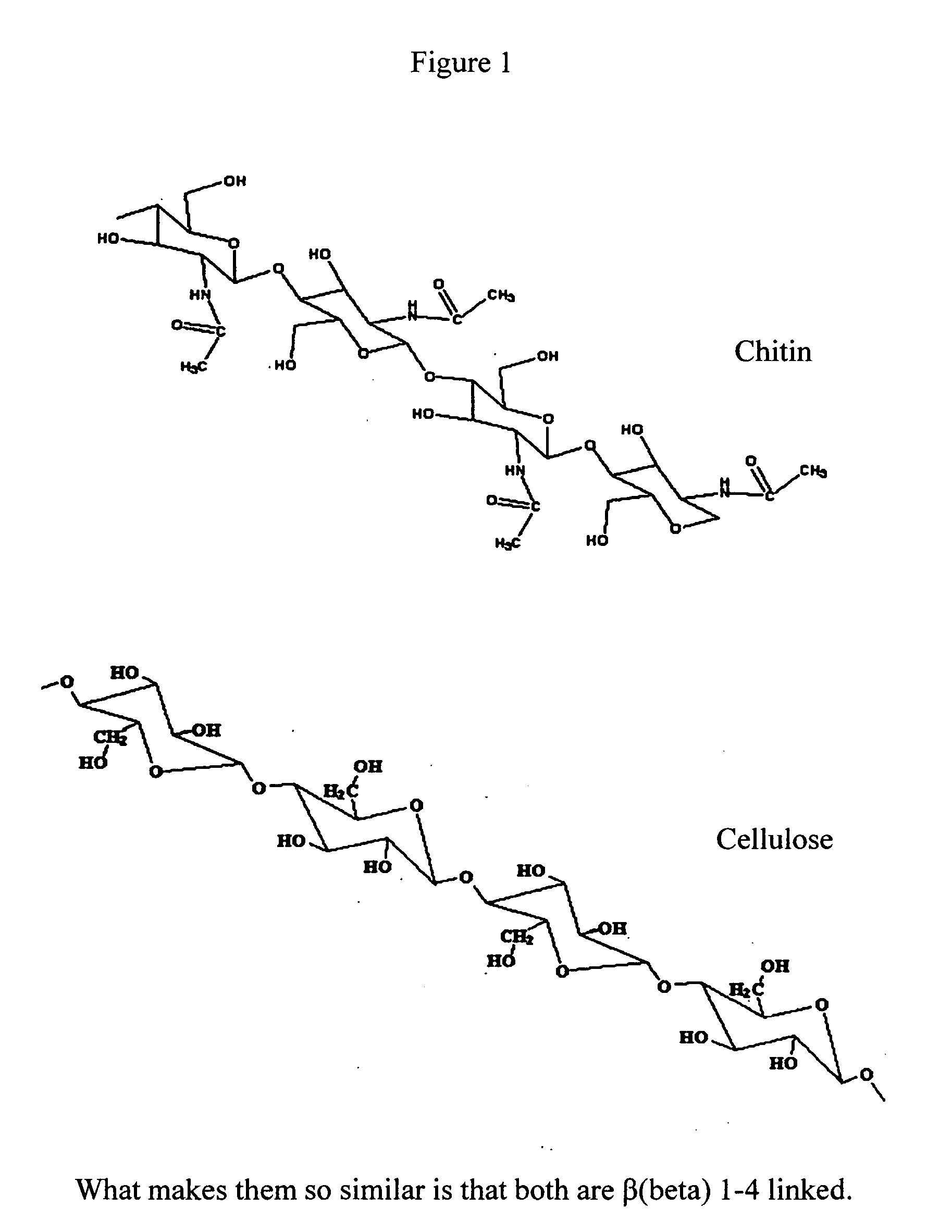Chitosan wound dressing
a wound dressing and chitosan technology, applied in the field of chitosan wound dressing, can solve the problems of inability to conduct studies, no preparations of chitosan, and inability to achieve the effects of reducing bleeding, preventing bleeding, and reducing bleeding
- Summary
- Abstract
- Description
- Claims
- Application Information
AI Technical Summary
Benefits of technology
Problems solved by technology
Method used
Image
Examples
example 1
[0022] Chitosan, in an amount of 29 grams having a 200,000 centepoise (cps) viscosity was added to 550 ml of 8% acetic acid prepared by appropriately diluting glacial acetic acid with deionized or distilled water. Sodium bicarbonate in the amount of 19.2 grams is added to the chitosan-acetic acid mixture while stirring to produce a foam within the chitosan gel. Should it be desirable to enhance the amount of foaming of the chitosan gel thus prepared, it is possible to add approximately 1.5 to 2.0 grams of lauryl sulphate to the mixture while stirring which will increase the amount of foam that is entrapped in the chitosan gel.
[0023] Chitosan foamed gel, thus prepared, can be transferred to dispensing tubes and the bottom sealed so that the product may be sterilized by appropriate sterilization means and be provided to healthcare institutions that need only squeeze the gel onto a bleeding wound through the orifice of such a contained tube. Alternatively, the foamed chitosan composit...
example 2
[0024] If desired, the chitosan gel as prepared in Example 1 can be prepared as a gel which is layered onto a suitable backing, such as polyurethane, polyester, or cotton backing and dried at 125-130° F. for 8-10 hours so resulting in a dressing which has a backing to it. The preparation of the gel prior to layering onto the backing may have the following composition:
chitosan - 200,000 cps29gramsacetic acid 8%550mlStir and mix.sodium bicarbonate19.2gramsStir and mix.lauryl sulphate1.5gramsglycerin10mlpropylene glycol5mlpolyethylene1gramStir to mix
[0025] The polyethylene may be optional depending upon the viscosity of the final product that is desired to be layered onto a suitable backing or depending upon the viscosity of the final product that is required to fill a dispensing tube from which the foamed chitosan composition may be dispensed into and onto a bleeding wound.
example 3
[0026] Properties of the chitosan gel as prepared in Examples 1 and 2 can have its softness and pliability enhanced by adding sodium alginate and an amount of calcium gluconate and Tween 80, the ingredients of which would make the chitosan gel more pliable when layered on a suitable backing and dried for use on wounds that require a hemostatic agent. Such a composition could be:
chitosan - 200,000 cps29gramsacetic acid 8%550mlStir and mix.sodium bicarbonate19.2gramsStir and mix.lauryl sulphate1.5gramsglycerin10mlpropylene glycol5mlpolyethylene1gramStir to mix.sodium alginate7gramscalcium gluconate2gramsTween 80 ®, Atlas Chemical Industries, Inc.9ml(polyoxethylenesorbitan monooleate)
PUM
| Property | Measurement | Unit |
|---|---|---|
| weight | aaaaa | aaaaa |
| soluble | aaaaa | aaaaa |
| surface active | aaaaa | aaaaa |
Abstract
Description
Claims
Application Information
 Login to View More
Login to View More - R&D
- Intellectual Property
- Life Sciences
- Materials
- Tech Scout
- Unparalleled Data Quality
- Higher Quality Content
- 60% Fewer Hallucinations
Browse by: Latest US Patents, China's latest patents, Technical Efficacy Thesaurus, Application Domain, Technology Topic, Popular Technical Reports.
© 2025 PatSnap. All rights reserved.Legal|Privacy policy|Modern Slavery Act Transparency Statement|Sitemap|About US| Contact US: help@patsnap.com

